|
>
 Agra Agra
The existence of Agra can be traced back to the Mahabharata where Agra is mentioned as 'Agrabana', an integral part of Brij Bhumi or the land of Lord Krishna. But its origin is said to be in the reign of Raja Badal Singh in 1475 AD. Agra was made the capital by Sikander Lodi, the Afghan king. After that, it was made the capital by four Mughal kings Babur, Akbar, Jehangir and Shah Jahan. Babur did not have much time to construct a city or a palace for himself in Agra but he made his contribution to Agra by building a garden called the Aram Bagh, which later on corrupted to Ram Bagh. The body of Babur was first buried here before being taken to Lahore.
Akbar made Agra its capital and started the construction of Red Fort in 1565 AD. It was initially made as the military fortress of mud and bricks on the banks of the River Yamuna. The fort is 2.5 km long with 20 ft high walls. The outer walls had two gates called the Amar Singh Gate on the southern side and the Delhi Gate on the western side respectively. The Delhi Gate was used as the main entrance gate. Both gates are sheathed in red sandstone and consist of an enormous facade flanked by twin towers. The entry is in several turns of ninety degree to foil invaders. A deep moat surrounds the fort. Jehangir and Shah Jahan made several additions during their respective reigns and added white marble to rose-red sandstone. Akbar built the Jehangiri Mahal, the earliest of all the structures, as the women's quarters. Akbar also built the Jehangir Palace for his favorite son. Out of 500 buildings inside the Red Fort, only a few remain intact today. These buildings are a classic example of the Indo-Islamic architecture.
The Jehangiri Mahal (Jehangir's Palace) was the principal royal
zenana palace used mainly by the Rajput wives of Akbar. A magnificent
gateway leads to an interior courtyard, which is surrounded by massive
halls covered with profuse carvings on stone, heavily fashioned
brackets, piers, and crossbeams. One can still spot remnants of
decoration in gold and blue done in the prevalent Persian style.
The Jehangiri Mahal is the admixture of the Trans-Oxanian (Central
Asian) features such as the balcony on the east front with its high
slender columns as well as the Rajput features. The typically Gujarati
brackets, fabulously carved animal and floral motifs, register a
dominating effect on the few Islamic features such as the verandah
on the eastern front with exquisitely slender pillars facing the
riverfront. The Jehangiri Mahal is the most important building of
the Akbar's period in the Agra Fort.
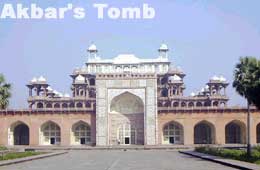 The Diwan-I-khas (Hall of Private audience) was built between 1636 and 1637 AD to receive the important dignitaries. It is a small hall with double marble columns inlaid with the pietra dura decoration. There are two marble thrones in the front of the hall on the terrace. Below this terrace lies the grand courtyard called the Machchi Bhawan lies below the terrace, which was meant for the harem functions. On the opposite side stands the small mosque built by Aurangzeb for Shah Jahan. The Diwan-I-khas (Hall of Private audience) was built between 1636 and 1637 AD to receive the important dignitaries. It is a small hall with double marble columns inlaid with the pietra dura decoration. There are two marble thrones in the front of the hall on the terrace. Below this terrace lies the grand courtyard called the Machchi Bhawan lies below the terrace, which was meant for the harem functions. On the opposite side stands the small mosque built by Aurangzeb for Shah Jahan.
The Diwan-I-Aam (Hall of Public audience) was constructed by Shah Jahan by replacing an earlier wooden structure. The arches are made of white lime polished to a smooth finish. The triple arched royal canopy has lavish ornamentation of the pietra dura work. The famous Peacock Throne of Shah Jahan was kept here. He met officials and commoners and listened to them over here.
Both Jehangir and Shah Jahan were in love with white marble and thus demolished many of Akbar's red sandstone structures. The Khas Mahal is an airy edifice, overlooking the specially laid Angoori Bagh or Grape Garden. The windows made with jali or latticework present fabulous view of the riverfront. The two copper-roofed pavilions built in the Bengali traditions were meant for prominent ladies of the harem. The three sides of this garden are surrounded by the residential quarters of the women. The Sheesh Mahal (Mirror Palace) and the Royal Hammam (Bath) is decorated with myriad glass pieces and have a fountain in the center.
The Musamman Burj is the most ornamented pavilion where Noor Jahan and Mumtaz Mahal lived. The quality of pietra dura decoration is fabulous and perfect. Shah Jahan spent his last few years here looking at the Taj Mahal.
Further in the north stands the Moti Masjid or the Pearl Mosque.
It has three domes in white marble rising over the red sandstone
wall. The Moti Masjid is known for its sheer grandeur, calm beauty
and perfect proportions. The Red Fort was included in the list of
UNESCO World Heritage Sites.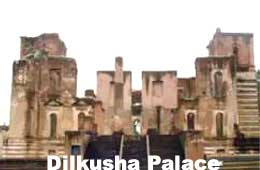
The Fatehpur Sikri is 16 km from Agra. It was build by Akbar between 1570-1586 AD in red sandstone. But it was abandoned within 20 years of its construction because of severe scarcity of water. Sikri was the small village and had the royal mint of the Mughals. This fort was build around the Dargah of Salim Chisti. The buildings in this fort have been built in Gujarati and Rajasthani architectural styles, using the help ornate columns, fanciful jali work, sumptuous carving and surface ornamentation. All the structures at Fatehpur Sikri are at an upper level because the climate was very hot over there.
The Diwan-I-Aam has the royal pavilion overlooking a large open area where petitioners and courtiers came to meet the king. Just behind it stands the Diwan-I-khas, which was used for confidential, diplomatic and religious discourses. The famous stone column stand in the middle of the room, sprouting 36 elegant brackets carved in the Gujarati style.
The Panch Mahal is a five storeyed pavilion supported by pillars in receding order for the ladies of the harem. Originally jali screens stood between pillars. The Jodha Bai's palace has the most distinctively Gujarati and Rajasthani architectural features The Turkish Sultana's palace is known for exquisitely carved dado panels depicting wildlife-lions, birds and foliage. The Mariam's Palace is also noteworthy for European architectural style. All the three palaces represented the cultural and religious background of the queen's of Akbar.
The central platform at the Anup Talao is linked by four bridges. Here court musician Tan Sen played music. Akbar's private apartments stand close to the tank. The Birbal's Palace and the Stable for the horses are also worth seeing. Most of the places have names invented by misinformed guides to please still more misinformed visitors.
The Jami Masjid, sacred center of the Sikri, symbolizes the city's spiritual prominence. In the vast courtyard stands the tomb of Sheikh Salim Chisti whose blessings are still sought by childless women. Akbar came here for the blessing of the Saint for a son. He promised that if he had a son he would name him after the Saint and cover the dargah with white marble. Earlier it was made of wood and stone. Later Salim (Jehangir) made the entire structure of the marble. The jali work on the dargah is intricately carved in white marble and each window has a different design. The 54 m high Buland Darwaza or Tower of Victory is the southern gateway to the Jami Masjid and the mausoleum of the Saint Salim Chisti. It was built in 1575 AD to celebrate Akbar's victory over Khandesh in Gujarat. It is the most stupendous architectural work of the Mughals and is the highest gateway in Asia.
Fatehpur Sikri had a short life of splendor. It was included in
the list of UNESCO World Heritage Sites. Sikandara is 4 km from
Agra. The Akbar's tomb was initiated by Akbar during his lifetime
in the Timurid tradition but was completed by his son Jehangir.
It stands amidst a large walled garden in the Charbagh pattern.
It has the most magnificent gateway covered with floral and geometrical
arabesque decoration in white and colored marble. It is crowned
with four elegant minarets in white marble, which were used for
the first in any tomb and were an inspiration for the four minarets
of the Taj. The tomb is decorated with marble on red sandstone and
calligraphy. The gateway is a stately composition. Its high central
arch is flanked by others in two storey. The tomb is in the pyramidal
style. On the uppermost terrace, a replica of the sarcophagus lies
open to the sky. Large panels of superbly crafted jail or filigree
screens form the outer wall of the verandah on all four sides. Akbar's
grave lays in the basement, reached through a portico covered with
superb stucco paintings in gold, blue and green floral arabesque
of Persian inspiration. The tomb is unique in architecture because
it is the only tomb without a dome. Sikandara is one of the most
beautiful Mughal buildings.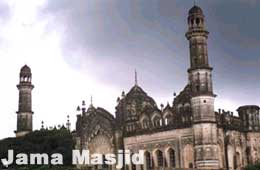
In 1628 AD, Noor Jahan, queen of Jehangir, built the tomb for her father Itmad-ud-Daula. It is the first ever tomb in India to use pietra dura, which is the inlay work of precious ad semi-precious stones. The decoration depicts cypresses, wine glasses and an amazing variety of geometrical arabesque. The jali screens set in arched recesses are splendid. Four small minarets rise at the four corners of the small tomb structure. It is placed in the walled garden overlooking the River Yamuna and is crisscrossed by channels of water.
The Chini ka Rauza is the Tomb of Afzal Khan who was a minister of Shah Jahan. It was built in 1639 AD. The high domed structure was originally covered with glazed tiles in glorious blue, green and yellow colors. Now it is in ruins. The tomb is truly Persian in concept.
Taj Mahal is a tribute from Shah Jahan to his favorite wife Arjumand Begum, popularly known as Mumtaz Mahal. Taj Mahal was constructed over a period of twenty-two years, employing twenty thousand workers. It was completed in 1648 AD at a cost of 32 Million Rupees. The tomb stands on a high podium in a grand paradise setting. Ustad Isa Khan was the master architect. Taj stands on a raised, square platform measuring 186 x 186 feet. It is a double-domed structure. The chamfered corners make it an irregular octagon. The architectural design uses the interlocking arabesque concept, in which each element stands on its own and perfectly integrates with the main structure. It uses the principles of self-replicating geometry and symmetry of architectural elements. There are four elegant tapering minarets, one at each corner of the platform inspired from the Akbar's Tomb at Sikandara. The minarets measure 162.5 ft each. Its bulbous central dome is 58 feet in diameter and rises to a height of 21 ft. It is flanked by four subsidiary domed chambers.
The real sarcophagi of the Mumtaz and Shah Jahan in the basement have their replicas placed directly above in the upper hall. The interior of the dome is decorated with pietra dura work and filigree work. The entire mausoleum is decorated with floral and geometrical pattern as well as calligraphy using precious gems such as agate and jasper. Taj is the best example of pietra dura work. The main archways are chiseled with verses from the Holy Qur'an. To the west of the Taj is a mosque and to the east is a replica of the mosque structure, which was used as the guesthouse.
The mausoleum is placed at the far end of an elaborate garden with the river Yamuna behind it. The large garden contains four reflecting pools dividing it at the center. Each of these four sections is further subdivided into four sections and then each into yet another four sections. The concept of Charbagh is derived from Islamic tradition. There is a belief in Islam that Jannat or Paradise is a place in the center of the garden. Hence there is a tradition among Mughals to make their tombs amidst a garden so that the body of the dead rest in piece.
Taj is colossal structural complex of gigantic proportions, each part harmoniously integrated into the ultimate concept. The total height of the Taj, including the podium and the copper finial is over 73 meters, slightly higher than the towering Qutub Minar in Delhi or equivalent to an 8-storey building. The entire covered area is larger than the Humayun's Tomb.
The white marble lends the tomb a certain air of purity. The overall ornamentation, through rich and exquisite, is restrained and does not look overdone. The calligraphic inscriptions are bold and rise in rhythmic grace. The screen around the sarcophagus on the upper terrace has stunning perfection, a worthier replacement for the original gold railing. The pietra dura floral decoration on the screen and the graves reveals an amazing depth. Sometimes there are as many as 64 types of precious stones like cornelian, coral, jasper, onyx, amethyst, lapis lazuli, turquoise, and jade used on a single bloom. The Taj Mahal represents the Zenith of Mughal architecture.
Lucknow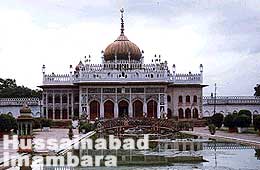
Lucknow has a rich past and glorious past. It is believed that lord Rama, Sita and Lakshman settled here near the river Gomti. Mahmud of Ghazni attacked Lucknow in 10th century AD. Lucknow was named after the "Qila Likhna'. In 1720 AD, the Mughal Emperors began to appoint Nawab-Wazirs from Delhi in lieu of a local subedar. From 1775 to 1797 AD, Nawab Asaf-ud-daula, son of Shuja-ud-daula moved from Faizabad to Lucknow. It was a mere village, which he turned into a rather grand place. From 1798 to 1814 AD, Nawab Saadat Ali Khan, the half-brother of Asif-ud-daula took over after the British removed the son of Asif-ud-daula, Wazir Ali.
The Nawab was quite playful and lived a lavish life. The Nawab had four thousand gardeners, several hundred cooks, a thousand dogs and 300,000 fighting cocks and pigeons. Began building the Bada Imambara with a true labyrinth where people have been said to have disappeared into some of the passages and never come out. From the roof, the view of Lucknow is breathtaking. He also built the British Residency, the Asifi Mosque, the Turkish Gate and the Chowk Bazaar.
Nawab Sadat Ali Khan built the Dilkusha Palace, the Bailey Guard Gate to the Residency, the Lal Baradari, the Begum Kothi and the Khursheed Manzil (for his queen and sweetheart). Nawab Saadat died of poisoning and is buried in the larger of the two-domed mausoleum at the edge of Kaiser Bagh. Beside him, in the lesser tomb was buried his chief wife, Khursheed Zaidi.
If Agra represents the pinnacle of Mughal architecture, Lucknow, capital of the Awadh Nawabs, represents the sad decline of a great architectural tradition. Lucknow rose to political prominence when the Mughal great power disintegrated in the 18th century.
Nawab Asaf-ud-Daula was a prolific builder. Because he could ill
afford building in marble, his brick structures plastered with lime,
finished in exquisite sheen and smooth surface, are still in good
condition. The Bada Imambara was built in1784 AD as a famine relief
project. It has the largest vaulted hall in the country measuring
49.4 meters in length and 16.2 meter in width under a 15 meter high
ceiling. Just below the ceiling is the viewing gallery meant for
the royal seraglio. The maze of passages on the upper terrace actually
reduces the weight of the roof built without any girders and external
support. This magnificent structure stands within a walled complex,
and there is an ancient baoli (step tank) and a grand mosque in
the imambara compound. 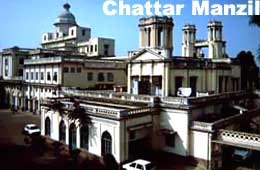
The Rumi Darwaa is an ornamental gateway, built to resemble on
ornate gate in Constantinople. The Rumi Darwaza is an extravagantly
bold in concept. Its quaint beauty is still undiminished. The Husainabad
Imambara is an ornate structure with a gilded dome and a cluster
of small turrets and minarets. At some distance stands the Jami
Masjid, beautiful with its triple onion-shaped domes.
The Residency was the Pleasure Palace for Asaf-ud-Daula built in the midst of a large garden, was occupied by the British during the 1857 struggle for freedom. It is now in sheer ruins but its bullet-ridden walls and roofless halls suggest a splendid past. The La Martiniere was the last remarkable structure built in Lucknow by the French adventurer Claude Martin. It presents a curious melange of Indian and European architectural features.
Lucknow has other unique buildings like the Chattar Manzil, the Qaiser Bagh, the Shah Nazaf and many more in a very dilapidated condition. There was little left in the treasury of the Nawabs of Lucknow to be invested in architectural projects and their days of glory were fast coming to a sad end, precipitated by the British presence.
|